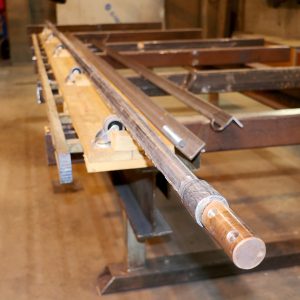

The conveyor’s tail end drum ready for lathing.
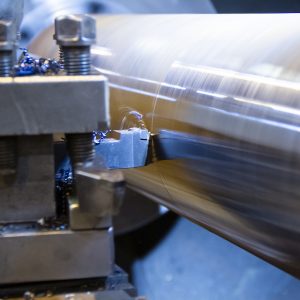
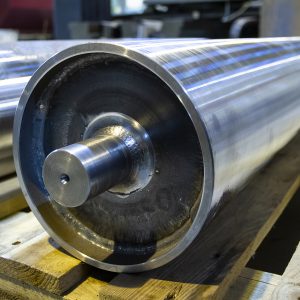
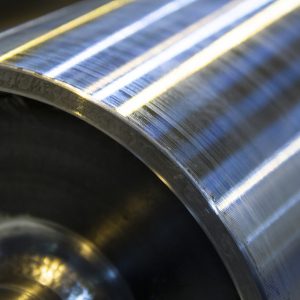
We repaired a mixer shaft. Before the repairs, crack inspection were carried out on the shaft, and other required repairs were recorded and reported to the customer. The shaft was repaired based on observations. The material was super-duplex steel.
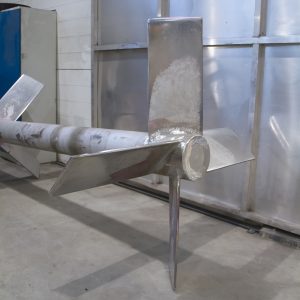
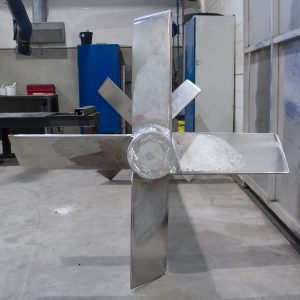
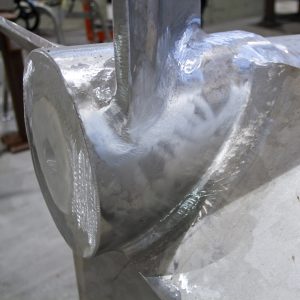
We serviced a screw conveyor. Servicing improved the materials of the screw flights and the shaft seals. We also made manufacturing drawings for the conveyor. The screw conveyor is made from stainless steel.
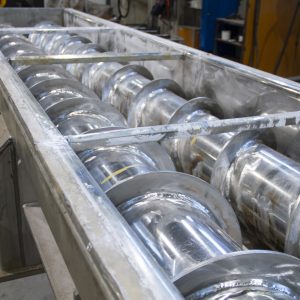
We delivered a staircase assembly for personnel access.
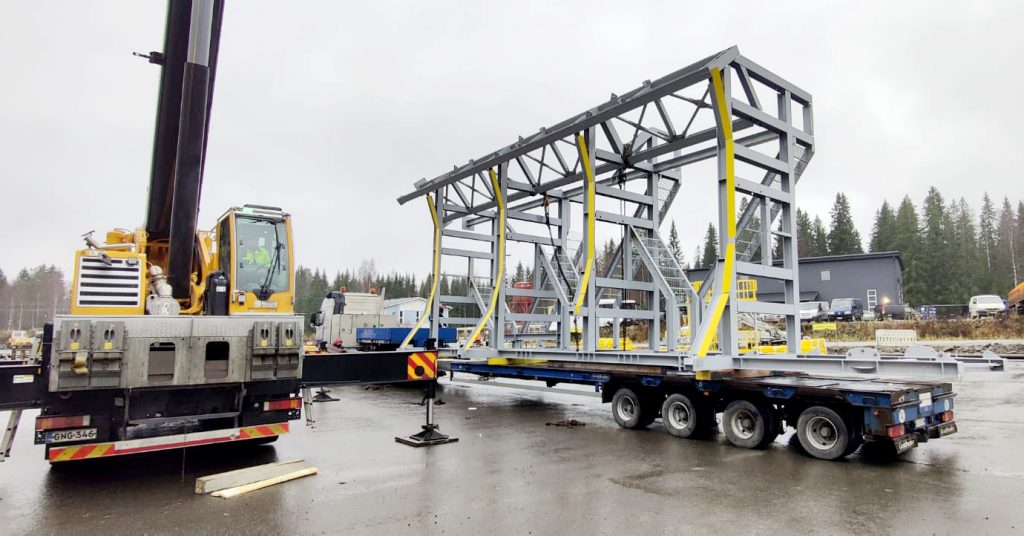
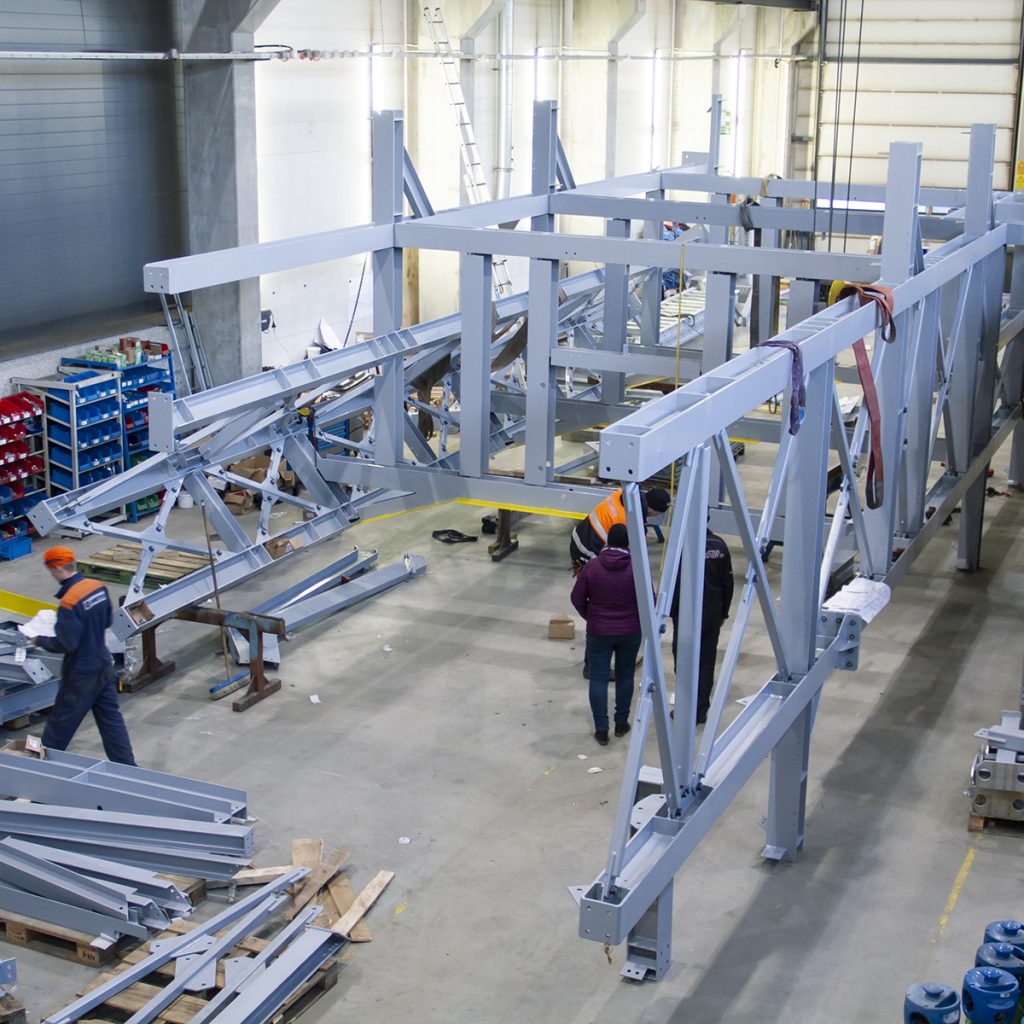
Simetek delivered a district heating booster pumping station to Savon Voima. The pumping station is critical in industrial waste heat recovery. The manufacturing method used for the pumping station was unique.
The delivery was exceptional in that the entire pumping station was delivered pre-installed and ready for use. Simetek designed and manufactured a steel base for the station, and floor insulation for the base was also added. The piping manufactured by Simetek was assembled on top of the base. The plan for the pipes was provided by Elomatic. Only the walls and ceiling had to be erected on site.
“At first, the plan was for the pumping station to be constructed on a concrete slab. That would have required lots of installation welding and lifting. Together with the customer, we decided it would be a good solution to build the pumping station on a steel base. This meant that the base could be manufactured as much as possible at the machine shop to prevent the pumping station from being left at the mercy of the weather for too long,” explains Simetek’s managing director Timo Roivainen.
The customer agreed that the ready-for-transit solution was extremely functional and cost-efficient. Savon Voima’s operations manager, Mika Sutinen, says that the base solution was well-designed and withstood lifting with a gantry crane well. Simetek’s work was well-organised.
“The complete delivery was exactly as planned, and Simetek’s work is of a high quality. During the project, we were kept informed about what phase of manufacture was under way, and Simetek kept to the schedule, even though we had to wait for some components with longer delivery times.”
Simetek gave a reliable and credible impression
Savon Voima’s Siilinjärvi unit has also entrusted Simetek with other commissions. According to Sutinen, the unit benefits from sharing a village with such a cooperative machine shop.
“Even though we’ve collaborated with Simetek for a long time, this was the first heating station that we carried out together. We are pleased with the project. We are also considering preinstallation for the implementation of future heating stations, too.”
Simetek left a reliable and credible impression on Sutinen. In addition to high-quality work, the hall was kept clean, and flexible negotiations on implementation methods went smoothly.


Simetek’s design department operates under the same roof as the machine shop. Close cooperation between the two departments improves the manufacturability of products and therefore generates cost savings for customers.
Manufacturability plays a key role in the design of large production cells and equipment. Simetek’s design department carefully considers how to manufacture a product and, if necessary, pictures for every work phase can be given to production phase workers, such as machinists, welders, and painters.
“I would say that our mechanical designers are more familiar with manufacturing methods than they would be in a traditional design office. It is a significant advantage for production and design to be able to communicate so easily,” says design manager Pasi Knuuttila.
Looking at things from different perspectives
Designer Matti Hirvonen also thinks that the collaboration between Simetek’s design department and machine shop is a good thing. Things can be considered from different perspectives as work progresses. If a design is missing a detail, it’s easy to pop over to the machine shop to take a look and solve the problem together in practice.
“We can also use our experienced welders’ decades of knowledge of certain welds and working methods in design, and we value their input on how they should be done in practice. It might be easy to make something complex on a screen, but reality can be very different.”
Design also considers product lifecycles
The main focus of mechanical design at Simetek currently is on conveyors and various production cells and equipment, but smaller implementations are also possible, if necessary. Product design considers the lifecycle of a product; that is, how to ensure in practice that the product can be maintained.
If a customer requires a new machine for an old space, laser scanning is used to measure the space. This method of measuring is reliable and allows for all measurements to be obtained at once.
“We also offer our customers layout design along with budget quotes, so that it’s easier to calculate funding for a large investment,” explains Knuuttila.
Simetek designed, manufactured and installed a train wagon towing device for Kraton Chemical Oy’s factory in Oulu. The turnkey delivery also included electric automation and excavation work.
Train wagons carrying raw tall oil to Kraton’s plant move in pairs, each carrying two containers per wagon. Once the first container has been emptied, the wagons must be moved in order for the next container to line up with the unloading point. Previously, the wagons were moved using a wheel loader, but this was risky, expensive, and difficult.
“The main purpose of the towing device is to be able to adjust the position of the wagons without needing to wait for outside help,” explains project manager Ville Kinnunen from Simetek.
Simetek designed and manufactured the towing, or winching, device and its steel structures, such as the draw line’s drums, dolly and cable track. Simetek also manufactured a protective enclosure around the device. The turnkey delivery also included the planning of excavation and casting work, as well as the dimensioning of the winch site.
“We wanted to improve safety in the unloading area. We hoped that the new device would be quick and easy to install, and that it would be reliable. Simetek succeeded good in achieving these goals,” says maintenance manager Riiko Ahonen from Kraton
The project involved collaboration with many different actors: a local construction company handled the installation of prefabricated elements and casting work while SEW-EURODRIVE Oy carried out electrical and automation planning and provided transmission housing.
“We received a commission and the initial data from Simetek. Based on the initial data we were able to dimension the drives and planetary gears used in the system. Collaboration with Simetek went very well, as it always has. Simetek has been a good partner to us for more than 10 years,” explains regional sales manager Petri Poimaa from SEW.
SEW and Simetek also collaborated on the remote monitoring of the device. A local electrical company connected the automation equipment and gears on site.
Test runs were carried out in Simetek’s own hall
The project began with an initial visit by Simetek to the Kraton factory in early spring 2019. Soon after, planning and workshop manufacturing began. There was a slight delay when Kraton requested the suspension of the project.
“We wanted to push back the project to the following year due to our own project management reasons. Simetek was very understanding about the delay,” says Ahonen.
In early spring 2020, the project was once again given the green light and continued as planned. At that time, workshop work had already been completed and the installation of the equipment could begin.
“We carried out the first test runs in our own hall. Luckily, we have so much hall space that we were able to test the equipment at its final size. We didn’t bring any train wagons indoors, though,” laughs Kinnunen.
A made-to-measure project
The train wagon towing device was custom-designed to meet the customer’s wishes. It required the ability to put preliminary mechanical engineering data, such as the masses to be moved and the distances, into practice.
According to Kinnunen, the installation was easy to implement, as plenty of preparation had gone into the work and the installation was well-designed. There was no need for any last-minute procurements on site. Kinnunen believes that the train wagon towing device is the kind of product that could be adapted for use elsewhere.
“Simetek did a great job for Kraton. Collaboration was smooth and flexible,” says Ahonen in thanks.
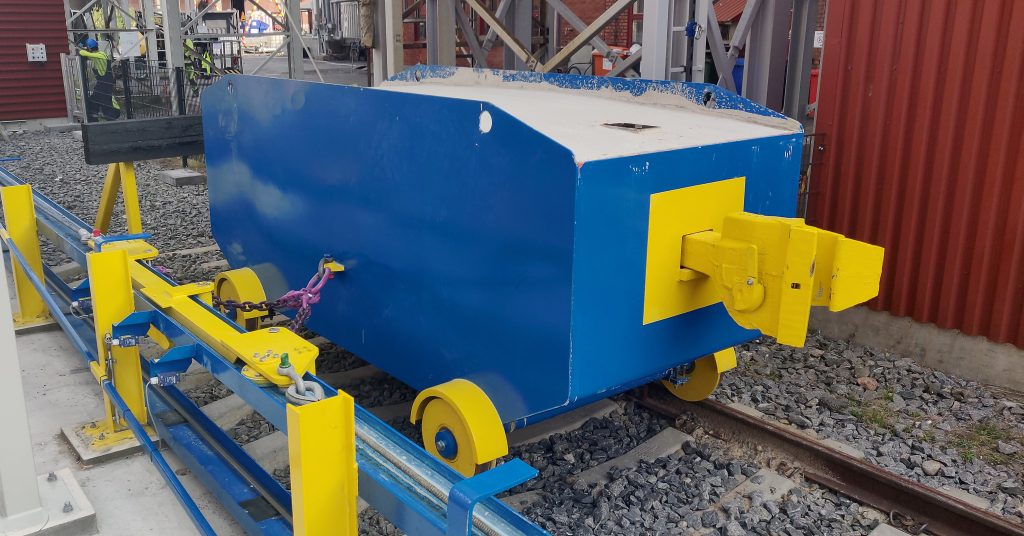
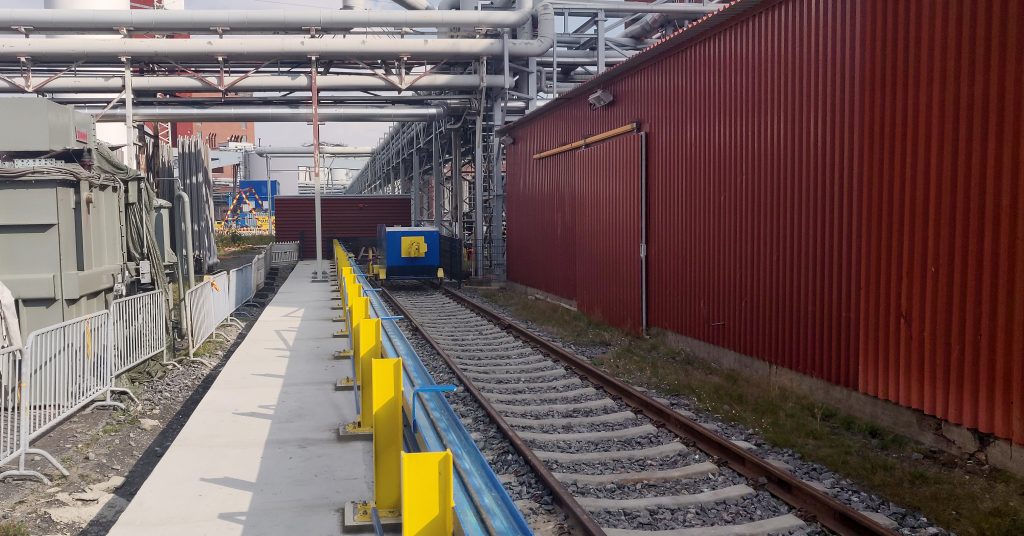
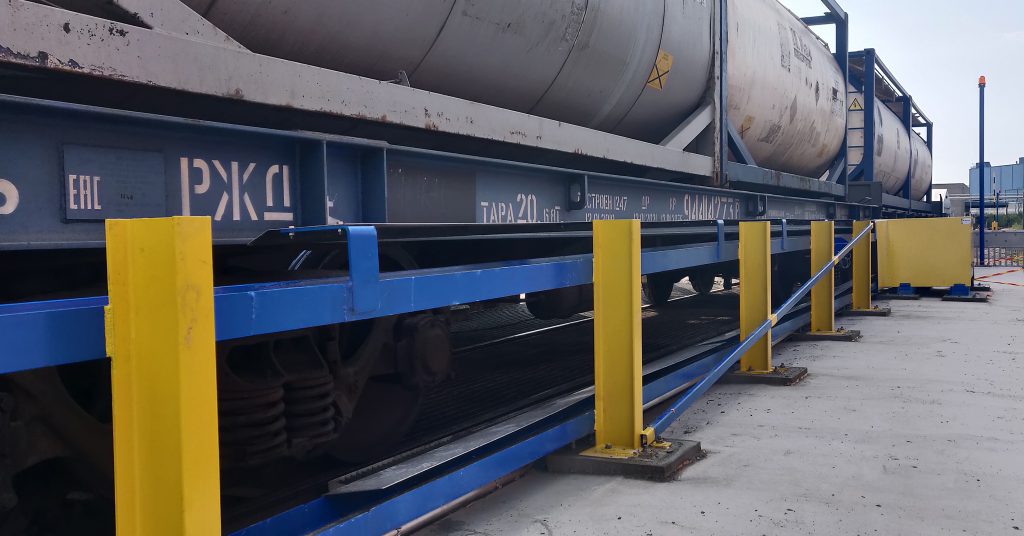
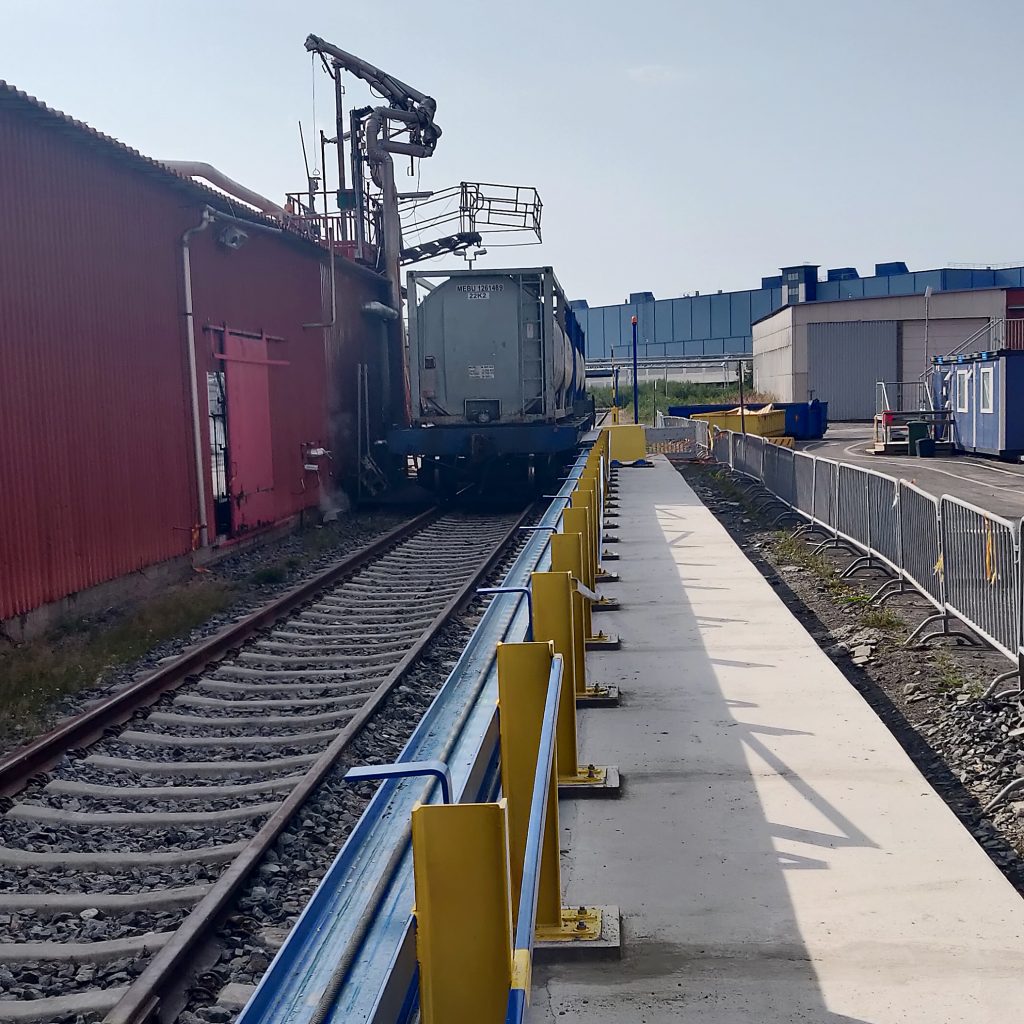
Simetek offers industrial gearbox maintenance as urgent work and as planned annual maintenance.
Simetek can provide a full-service maintenance package for gearboxes: we can detach the gearbox, service it, and then re-install it back into place. In connection with the maintenance, we measure and check the components, and if necessary, the gearbox can be surface treated again.
“Some industrial gearbox maintenance is agreed in advance, but sometimes it can be urgent and unexpected, for example if something in a gearbox has broken,” explains Ringo Markkanen from Simetek.
The range of gearboxes that require maintenance varies widely. Gearboxes come in different sizes and are used for a range of purposes. For example, the drives at the end of conveyor belts are typically implemented using a gearbox. Gears are also used to run many kinds of crushers and axles.
Urgent maintenance in two shifts
At mines, quarries or at energy plants, a damaged gearbox can result in a situation where the material flow is slowed or broken entirely. In such cases, the gearbox needs to be repaired urgently so it can continue its task.
“Gearboxes can be very urgent. Especially if you have no back-up equipment,” says Markkanen.
Simetek carries out maintenance in two shifts if the customer needs their gearbox back in operation urgently. Markkanen gives an example of urgent maintenance carried out on a leaking gearbox for a customer. The device was fully serviced, including bearings, seals, cleaning and painting, in less than a week. The gearbox weighed around 5,000 kilograms and had 46 bearings.
Gearbox maintenance is customised to meet the customer’s needs
Maintenance procedures are always planned in collaboration with the customer. Typically, a condition inspection and basic maintenance are carried out on gearboxes, with the components washed and bearings and seals replaced.
“During maintenance, we also check to make sure that it’s even worth servicing the gearbox. We contact the customer if something inside the gear has broken and it isn’t possible to source the spare parts from the original manufacturer, or if the costs of maintenance are higher than the cost of purchasing a new gear. We explain the situation and then go through the options,” explains Markkanen.
Reporting makes up a large share of gearbox maintenance. A report outlines the condition of the gearbox before and after maintenance. The documentation means that the customer is given written documentation on the maintenance procedures carried out on the gearbox and on the condition of the gear. This means that the customer can plan the next date for gear maintenance, or even the date of procurement of a new gear, if the existing gear has reached the end of its service life.
We manufactured a fuel supply pipe made from fire-resistant materials for Napapiirin Energia ja Vesi Oy in Rovaniemi. Wear-resistant armour plating was used as wear protection and special additives were used in welding.